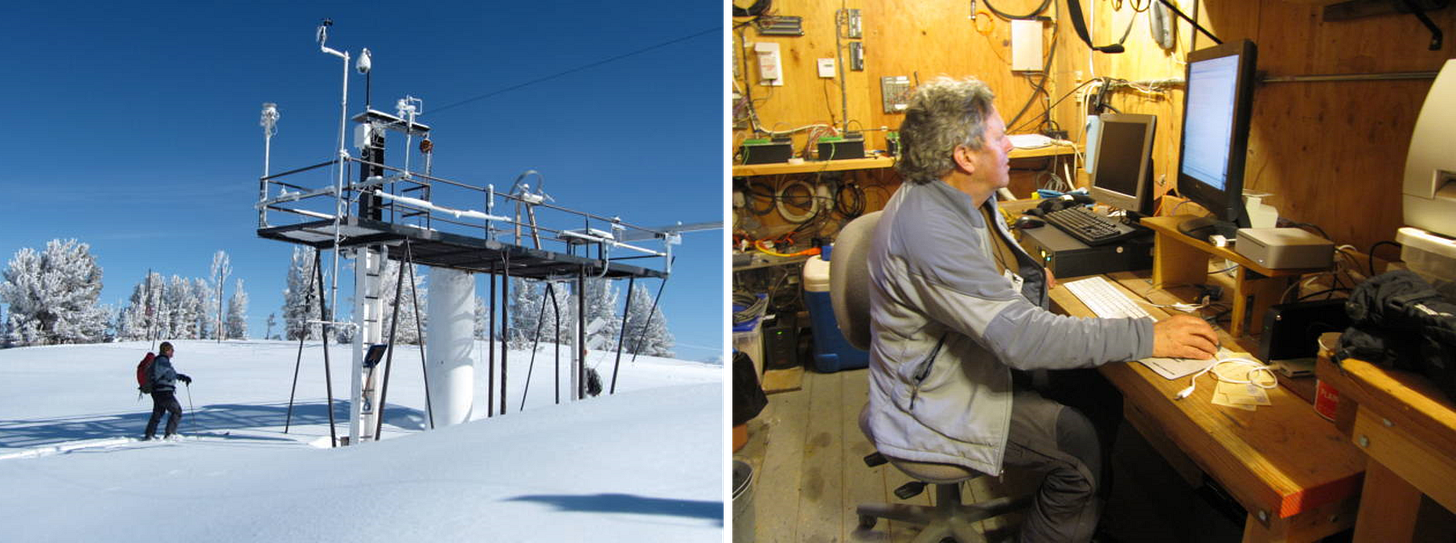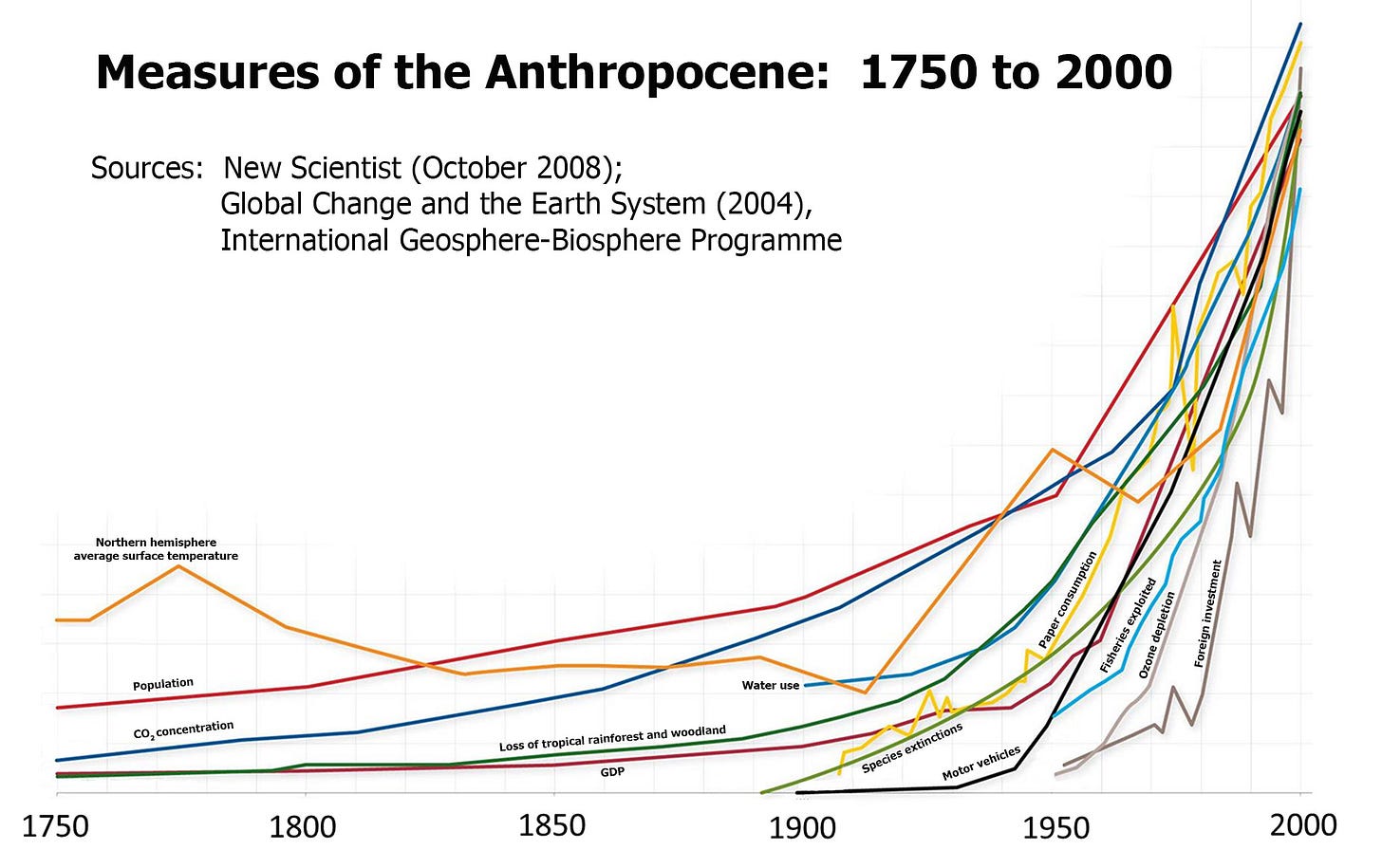Hello Interactors,
Today we begin the summer series on the environment. I didn’t seek learning about the physical world intentionally; I was more interested in maps. But as a geography major it’s unavoidable. Now I’m glad I was exposed to the workings of the natural world as we’re confronted with its wrath on a daily basis. Which begs the question, When did this calamity all start and what should we call it?
As interactors, you’re special individuals self-selected to be a part of an evolutionary journey. You’re also members of an attentive community so I welcome your participation.
Please leave your comments below or email me directly.
Now let’s go…
ENVIRONMENTAL DISCLOSURE FROM SNOWY JEFF DOZIER
I typically didn’t sit in the front of the class, but I was running late and the seats in the circular shaped domed Campbell Hall were full. It was a required class, Physical Geography 101, taught by geography legend, Jeff Dozier. By this point, Jeff had already earned a reputation for being a snow expert. Students would clamber to join him as a research assistance climbing up and skiing down Mt. Shasta studying snow hydrology. Nobody knows snow like Jeff. Who did Disney call to explain the dynamical elements of snow crystals to animators of the popular movie, Frozen? Dozier.

I ended up sitting in the front row from that point forward; not so much because I was interested in the topic, but because I wanted to see if I could hear what he was mumbling before the start of every class. He would pace back and forth on stage talking to himself as if nobody was there. Occasionally our eyes would lock, he’d blink a couple times staring at me, and then unexpectedly snap out of it. I think he clued on to me later in the term as the blank catatonic stare morphed into a sly grin and a gentle nod. Maybe I was more interested in observing this star-studded snow expert than I was physical geography.
His research over the last 40 years has been groundbreaking. In addition to dangerous and difficult field work in the nooks and crannies of mountainous cliffs and creeks revealing marvels of the molecular structure of snow, Jeff was equally comfortable behind a screen as a pioneering pixel prognosticator. As high quality digital imagery of the earth started flowing from satellites circling the globe, he realized much could be gleaned from the array of tiny white dots of varying intensity shining back at him through zoomed-in pictures of snow covered mountains; much of which inaccessible by foot or by ski – even by the most motivated graduate student.

With the radiance of a single pixel at one end and the physics of the silicon imaging sensor at the other, Jeff could determine mathematically how the atmosphere effected the radiation of light reflecting off the microscopic ice crystals that make up a snowflake. Later, with the help of a colleague, he also discovered this technique could be used for the opposite of snow – fire. Examining pixelated satellite imagery from the Persian Gulf, they detected anomalous glowing spots that dotted the landscape. These dots turned out to be small methane burn-off flames used in oil refineries. It was 1980 and for the first time a tiny fire could be detected from space. Soon he was able to determine land surface temperatures just by analyzing a satellite image. Remote sensing, spectroscopy, and biogeochemisty have come a long way in 40 years; so have fires – as dire global warming melts precious snow away like teardrops rolling down the creeks on the face of mother earth.
DIRTY SNOW AND ALLUVION FLOW
While Dozier was looking at the earth’s surface for climatic clues, other researchers were digging deep. Since the late 60s scientists have been extracting two-mile long ice cores out of snowpack in Greenland and Antarctica. More cores around the globe have been plucked out of glaciers before they all recede. Stacked in these cylindrical cores are stratified lines representing a geological timeline. Toward the top are layers of white loosely granulated snow crystals with barely discernable lines of annual layers of snowfall, then come darker compressed layers of rock, silt, and sand, with the bottom layers typified by dense dirty-brown ice. Some of these cores contain 750,000 year old natural elements.
These layers of ice allow scientists to travel back in time revealing snow fall levels, the direction the wind was blowing as the snow drifted, and the air temperature. By looking at the ratio of ‘light’ and ‘heavy’ atoms found in oxygen trapped in the ice, scientists can’t discern exact daily temperatures, but they determine average air temperatures or identify trends over select periods of time.

Other clues can be found as well; like elements in the atmosphere. As snow piles miles deep they compress lower layers ice pockets of atmospheric gas that become securely enshrouded. These gassy envelopes reveal to scientists the amount of methane and carbon dioxide in the atmosphere at the time of the snow fall. As water turns to snow the process captures other atmospheric particles like dust, smoke, pollen, or ash from volcanic plumes as they crystalize and fall to the earth.
Taken together scientists can correlate volcanic ash concentrations, for example, with rising carbon dioxide levels. By carbon dating the ash particles, they can determine when the volcano occurred. These can then be cross-referenced with other sediment layers found in past oceans and land forms to create a more complete picture of the earth’s physical history.
Imagine what future paleontologist and paleoclimatologists will discover in future layers of snow and rock. Sure there will be the usual fossilized remains of the disappearing and evolving species of plants and animals; biomass that took what was given from the earth and then gave it back in a natural symbiosis of reciprocity; and then is all blended together in piles of swirling dust, decomposed carcasses, sticks, and leaves in compressed layers of time. But what will stand apart from the medley of bio-miscellany will be the detritus of an animal that has taken more from the world than it was given. Humans.
LET’S PLAY THE NAME GAME
There’s a proposed term that describes this geological period of profound human impact; a marker for future generations denoting an impression on the world that is different from any other in the history of time. The proposed term is Anthropocene. But there’s a problem. Scientists can’t agree on the term. They can’t even agree on the motivations to name such a period, when it began, or if it has even begun. As recently as March 2021 the two biggest stakeholders on the topic, the International Commission on Stratigraphy (ICS) and the International Union of Geological Sciences (IUGS), both refused to approve and adopt the term as submitted by the Anthropocene Working Group, a subcommittee of the ICS.
One of the most contentious issues is determining exactly when the outsized human impact on the world’s systems began. The more scientists uncover and learn, the earlier the proposed starting date becomes. Other questions remain around the scale of impact, exact start dates, and the period of time over which the impact occurred.
Some argue that it began with the discovery of fire coupled with the cooking of meat. This combination increased caloric protein for developing brains which led to fires used to manipulate local living conditions. Or maybe it was the period of mammalian extinction when the world lost over half of its large animals; a time when Homo sapiens emerged out of Africa to spread throughout the world. Or was it just ten thousand years ago when farming emerged independently and coincidently in Africa, Eurasia, the Americas, and New Guinea? Perhaps it was two thousand years ago and the organization and formation of societies like the Roman’s in Europe, the Han dynasty in China, and others in India, Mexico, and Peru. After all, these societies, like ours today, clear-cut land and mined for minerals at large, albeit isolated, scales.
This leads to the period I wrote about in my spring series on cartography – the sixteenth century’s European colonization around the world. This facilitated interactions between people and place across oceans resulting in a global exchange of regional fruits, vegetables, and animals; evidence of which is visible in our sedimentary strata. It also created a world economy that America and Europe relished as they exploited land, radically diminished Indigenous populations through disease, slaughter and war, and stole humans from their homes in Africa and beyond for free slave labor. All of which gradually intensified energy consumption with the dawn of the industrial age.

But most seem to be focusing in on the Great Acceleration that began around the 1950s. This time marks obvious shifts in social and earth systems – all resulting from the interaction of people and place. It’s the point on exponential behavioral, economic, and physical geography curves that feature steady linear growth throughout human history and then sudden sharp climbs up dangerously steep slopes.
Complex interdependent systems exhibiting exponential growth become unpredictable on their way to a tipping point. We are sitting on a slope made of the outcomes of unprecedented and unpredictable global inputs and outputs from interdependent social and environmental systems too complicated to describe or fully understand. Which leads some scientists to contend perhaps we have yet to even begin a true Anthropocene given we don’t really know what we’re dealing with.
TAKE A CUE FROM A SNOWFLAKE
It’s worth mentioning that much of this hang wringing, research, discussion, and debate is dominated by the very societies that induced this monstrous blow to our existence. This has led to the emergence of satirical derivative names like:
“Capitalocene, highlighting the dominant role of the capitalist economy;
Plantationocene, highlighting the important seminal role of colonialism capitalism, slavery, and the plantation economy;
Technocene, emphasizing the role of technological systems;
Anthrobscene and Manthropocene, highlighting a male logic of resource exploitation and the largely male composition of expert panels deciding on the Anthropocene;
“Anthropo-not-seen”, highlighting indigenous perspectives and role of colonialism;
Anglocene, noting the dominant role of the English-speaking world in producing the earliest industrial greenhouse gas emissions and also dominating the contemporary debate about the definition of the Anthropocene…”1

I’ll add a couple more —
Anthropomorphicene, the attribution of human traits to earthly processes. Perhaps our nurturing mother earth isn’t a mother figure at all, but a fierce planetary tempest exacting indiscriminate damage on all it encounters.
Egocentricene, the obsession with our own well-being at the expense of other humans and non-humans. Perhaps we are getting what we deserve as we continually amuse ourselves to death. Sorry other plants and animals. Is it possible the human race, along with many more species, will expire before our greedy capitalistic consumerist ways do?
Maybe there is more uncertainty than there are species on the planet. It’s as complicated as the earth we inhabit. Perhaps more explanations exist than the ones we are handed.
I did learn one thing in Jeff Dozier’s Physical Geography 101 class; while snowflakes all have six arms, no one snowflake is ever like another. They all have a common symmetrical beauty that typifies the order molecules can produce as they take their rightful place in crystalline formations. But they are all unique.
As we seek to better understand the role human interaction has on this place, or even how we name it, let’s all acknowledge what we have in common while celebrating what makes us different. Nobody wants the human race to end, but no single answer will ever emerge for how to avoid it. So as you grumble to yourself in contemplation of your own existence, don’t forget to occasionally look up, make eye contact, nod, and smile at those around you.
The Concept of the Anthropocene. Yadvinder Malhi. Annual Review of Environment and Resources 2017 42:1, 77-104













